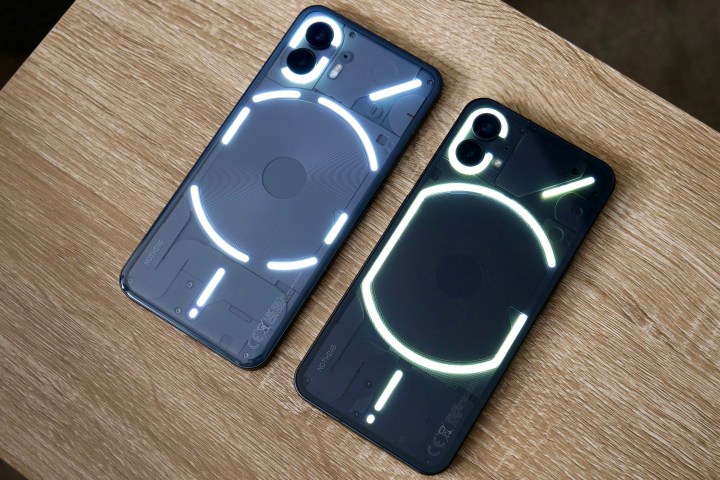
After skipping out on the U.S. for its smartphone debut, Nothing has brought its next phone, the Nothing Phone 2, to American shores. It’s trying to break into an established and crowded market, but the Nothing Phone 2 doesn’t seem worried. This new phone packs in some strong specs, including the Snapdragon 8+ Gen 1, an adaptable refresh rate that ranges from 1-120Hz, and — of course — the phone’s headline feature: The Glyph lighting system. This unique use of the phone’s back is gimmicky, sure, but it’s fun, and it’s sure to appeal to a lot of people.
- Nothing Phone 2 vs. Nothing Phone 1: specs
- Nothing Phone 2 vs. Nothing Phone 1: design, display, and durability
- Nothing Phone 2 vs. Nothing Phone 1: performance, battery life, and charging
- Nothing Phone 2 vs. Nothing Phone 1: cameras
- Nothing Phone 2 vs. Nothing Phone 1: software and updates
- Nothing Phone 2 vs. Nothing Phone 1: special features
- Nothing Phone 2 vs. Nothing Phone 1: price and availability
- Overall winner: Nothing Phone 2
While the Nothing Phone 1 wasn’t officially available in the U.S., it was still possible to import one — and it’s very obvious why someone would. Equipped with the same Glyph lighting system as its successor, the Nothing Phone 1 is also a strong performer, with specs that mean it’s capable of lasting for years. But, now the second phone is out, should it? If you’re already using the Nothing Phone 1, should you buy the Nothing Phone 2 instead? It’s always tempting to upgrade, but in this case, is it actually worth it? We took a look to find out.
Nothing Phone 2 vs. Nothing Phone 1: specs
| Nothing Phone 2 |
Nothing Phone 1 | |
| Size | 162.1 x 76.4 x 8.6 mm (6.38 x 3.01 x 0.34 inches) | 159.2 x 75.8 x 8.3 mm (6.27 x 2.98 x 0.33 inches) |
| Weight | 201.2 g (7.09 oz) | 193.5 grams (6.84 ounces) |
| Screen size | 6.7-inch OLED (1-120Hz) | 6.55-inch OLED (120Hz) |
| Screen resolution | 2412 x 1080 pixels (394 pixels per inch) | 2400 x 1080 pixels (402 pixels per inch) |
| Operating system | Android 13, Nothing OS 2 | Android 12, Nothing OS 1.1.0 |
| Storage | 128GB, 256GB, 512GB | 128GB, 256GB |
| MicroSD card slot | No | No |
| Tap-to-pay services | Google Pay | Google Pay |
| Processor | Qualcomm Snapdragon 8+ Gen 1 | Qualcomm Snapdragon 778G+ |
| RAM | 8GB, 12GB | 8GB, 12GB |
| Camera | 50-megapixel wide, 50MP ultrawide, 32MP front | 50MP wide, 50MP ultrawide, 16MP front |
| Video | 4K at up to 60 frames per second, 1080p at 60 fps | 4K at 30 fps, 1080p at 60 fps |
| Bluetooth version | Bluetooth 5.3 | Bluetooth 5.2 |
| Ports | USB-C | USB-C |
| Fingerprint sensor | Yes, in-display | Yes, in-display |
| Water resistance | IP54 | IP53 |
| Battery | 4,700mAh
Fast charging (45W) Wireless charging (15W) Reverse wireless charging (5W) |
4,500mAh
Fast charging (33W) Wireless charging (15W) Reverse wireless charging (5W) |
| App Marketplace | Google Play Store | Google Play Store |
| Colors | Dark gray and White | Black and white |
| Price | $599 | ~$480 |
| Review | Nothing Phone 2 review | Nothing Phone 1 review |
Nothing Phone 2 vs. Nothing Phone 1: design, display, and durability
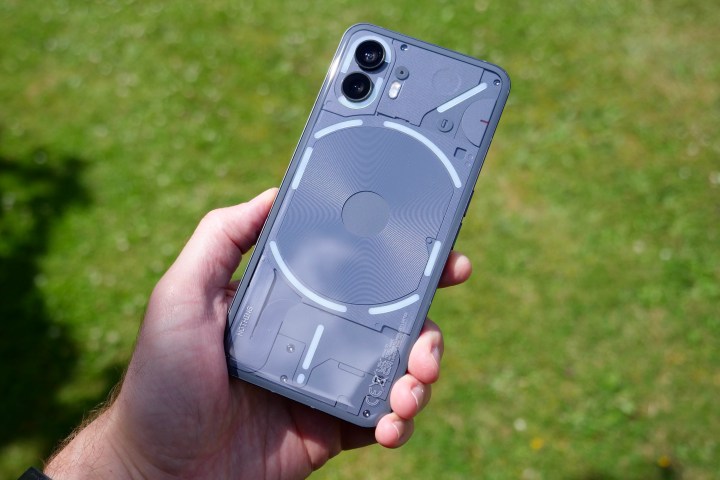
The Nothing Phone 1 looks like nothing else on the market — except the Nothing Phone 2, of course. At first glance, these two phones are very similar, but there are some key differences that set the two apart. Nothing has softened the Phone 1’s strong edges, and it makes the second phone much more comfortable to hold. Nothing uses the term “pillowed” to describe its new phone, and while that’s an odd way to describe glass, we have to admit it’s accurate.
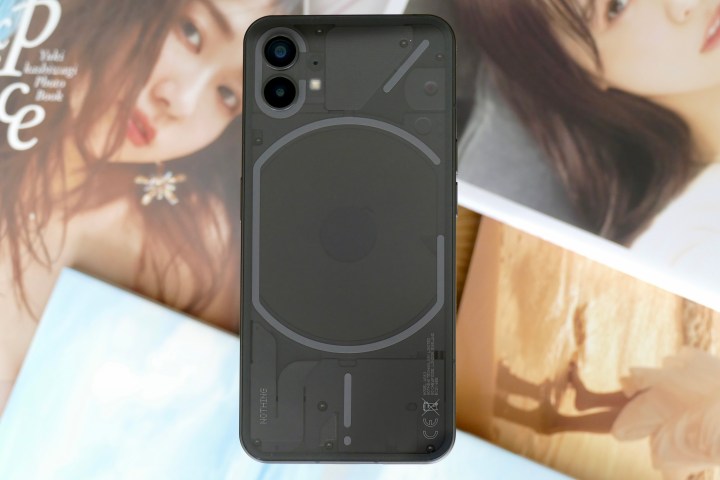
The Nothing Phone 1’s 6.55-inch OLED display was no slouch, with a 1080p resolution and 120Hz refresh rate, so it’s even more impressive that Nothing managed to improve it for the sequel. The Nothing Phone 2 has a similar OLED display with a 1080p resolution, but it’s been increased to 6.7 inches, and the refresh rate has been upgraded to a variable rate from 1-120Hz. Being able to shift from the higher refresh rates should mean a lower load on the battery.
It’s even a win for the Nothing Phone 2 when we look at durability, as it’s been upgraded to an IP54 rating for dust and water resistance. That means the Phone 2 can resist more splashing water than the first Nothing Phone, making it slightly more durable.
It’s a clean sweep for the Nothing Phone 2 here.
Winner: Nothing Phone 2
Nothing Phone 2 vs. Nothing Phone 1: performance, battery life, and charging
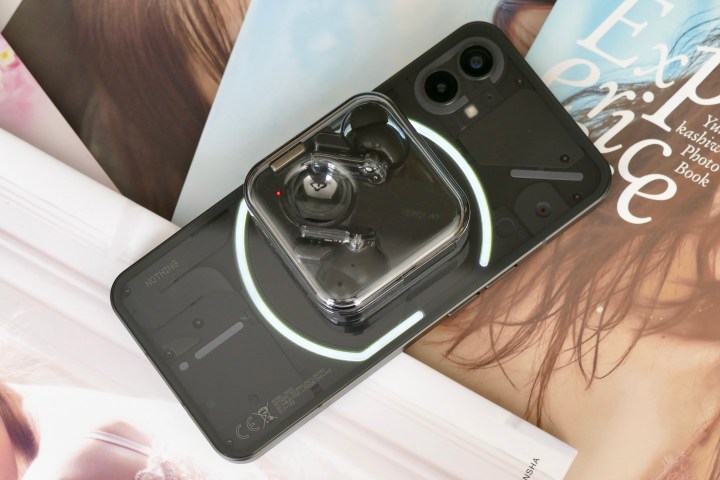
The Nothing Phone 1 uses a Qualcomm Snapdragon 778G+ processor and has up to 12GB of RAM, and as you might expect, that powerful combination means it’s a strong performer. It was smooth and responsive throughout our time with it, though it did start to struggle with heat buildup when playing demanding games like Asphalt 9: Legends or Diablo Immortal.
That’s not an issue for the Nothing Phone 2, which has the Snapdragon Qualcomm 8+ Gen 1, a vastly more powerful chip. In addition to a smoother gaming experience, the Nothing Phone 2 also doesn’t have any heat buildup issues and is smoother than ever for regular use. Plus, it also has the option to upgrade to 512GB of internal storage, whereas the Nothing Phone 1 was capped at 256GB.
What about battery life? The Nothing Phone 1 managed about a day out of a full battery. It was good endurance, but the Nothing Phone 2 has it beat. With light to moderate use, it’s very possible to get a day and a half — or two days — from a single charge on the Nothing Phone 2. It is possible to drain the battery in a single day, but you really have to be on it a lot to make that happen.
The two phones share identical wireless recharging and reverse wireless charging rates, though the Nothing Phone 2 has a 45W wired recharge — another serious upgrade over the Nothing Phone 1.
This is another win for the Nothing Phone 2. With better performance, faster charging, and much better battery life, it’s a solid improvement all around over the Nothing Phone 1.
Winner: Nothing Phone 2
Nothing Phone 2 vs. Nothing Phone 1: cameras
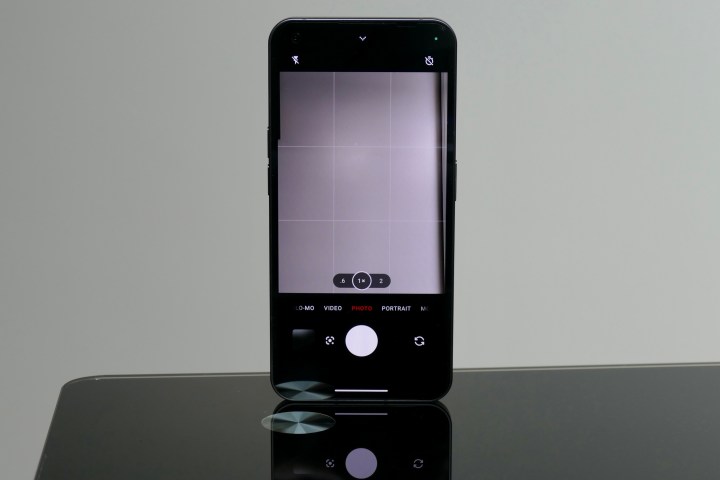
You’ll find similar camera setups on these two phones, as both have dual-lens rear suites, with a 50-megapixel wide-angle main lens and a 50MP ultrawide lens. Around the front, you’ll find a 16MP selfie camera on the Nothing Phone 1, while the Nothing Phone 2 has a 32MP selfie lens.
Although the hardware hasn’t changed very much, Nothing made a lot of improvements to the camera in the software department — and it shows. The Nothing Phone 1 never took outright bad photos, but the Nothing Phone 2 is more enjoyable overall. Color reproduction looks nicer, there’s much better consistency between the main and ultrawide cameras, and the 2x zoom mode (which uses the main camera) works surprisingly well. Neither phone does particularly well in low light, but beyond that, the Nothing Phone 2 is a solid upgrade everywhere else.
Once again, the Nothing Phone 2 takes the win.
Winner: Nothing Phone 2
Nothing Phone 2 vs. Nothing Phone 1: software and updates

One of the Nothing Phone 1’s biggest marketing tools was its much amped “Nothing OS” — a minimalist take on Android, with none of the bells and whistles we’ve come to expect from the more usual manufacturer reskin. In practice, it’s more like the clean version of
Since Nothing is new on the block, it’s hard to gauge how well it will do with updates. The Nothing Phone 1 received a stable update to Android 13 in February 2023, which isn’t the fastest update speed — but not terrible considering how much it has to do to adapt Nothing OS for a new version. Expect a similar update speed for the Nothing Phone 2. The Phone 2 will also get more software updates than the Phone 1, but that’s purely because it’s newer and not much of a reason to give it the win here. It’s a tie.
Winner: Tie
Nothing Phone 2 vs. Nothing Phone 1: special features
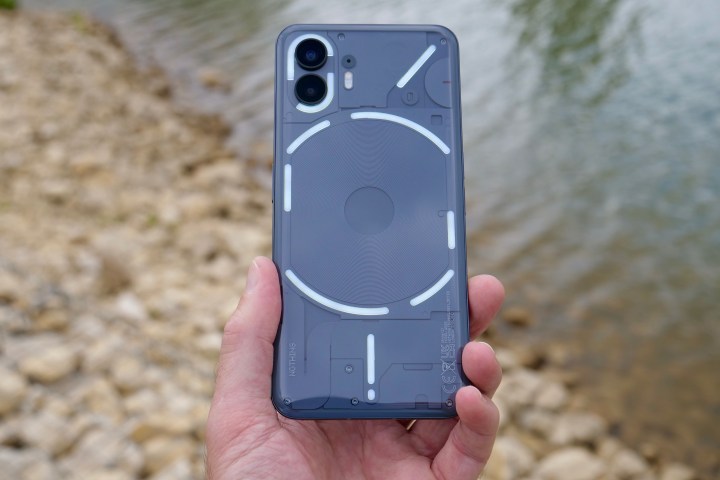
Both of these phones sport the feature that defines the Nothing Phone range — the Glyph Interface. Basically, a system of sounds, haptics, and the curious lighting rig on the back of both phones. The Glyph Interface is a gimmick, sure, but it’s one you might use more than you think. The Glyph lights up for notifications, charging, and when Google Assistant is listening, but there’s a lot of room to experiment with that. There are 10 different sets of ringtones and alerts to pick from, all of which vibrate and flash lights in different ways. Heck, it can even be used as a camera flash too.
The Nothing Phone 2 has this as well, but with some tweaks. The lights have been moved around, and there’s now a way to set up your very own combination of lights and sounds for your various notifications. There’s also added functionality, like using the Glyph lights as a timer or volume indicator. You can even tie the Glyph Interface into third-party apps too — like Uber — something sorely missing from the Nothing Phone 1. Finally, the Glyph light gets brighter and dimmer, giving it just that little extra touch of usefulness.
The Nothing Phone 2 wins here.
Winner: Nothing Phone 2
Nothing Phone 2 vs. Nothing Phone 1: price and availability

The Nothing Phone 1 was a real dark horse of a release, and it’s one of the phones we really enjoyed using last year. Unfortunately, it wasn’t available in the U.S., and that’s a big black mark for it. However, if you can find an international seller, then you can import it. Costs depend on the exchange rate, but you’ll normally be looking around the $400-$500 area.
The Nothing Phone 2 is available for preorder from Nothing, and units will ship from July 17. Prices start from $599 for the 8GB/128GB variant.
Overall winner: Nothing Phone 2
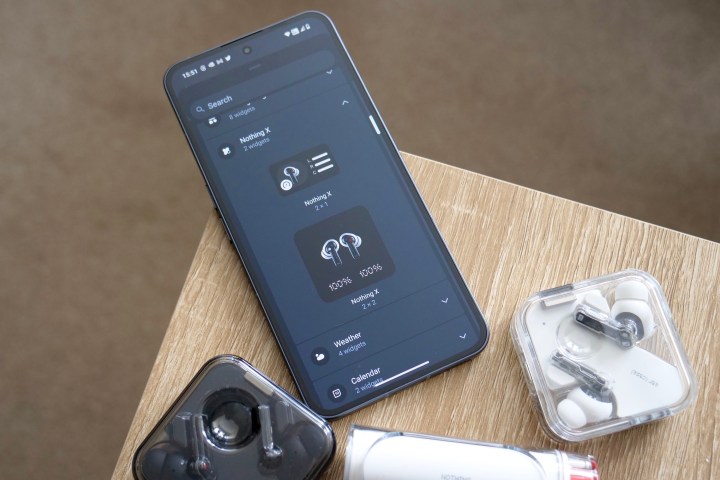
It’s never a surprise when the successor to a phone comes out on top. The Nothing Phone 1 was a great phone, but the Nothing Phone 2 pushes way beyond it, thanks to an upgraded processor, better cameras, a new Glyph Interface, and an improved design and display.
But that’s not really the question we were asking here: The question was “Should you upgrade?” — and that’s a tougher question to answer. Yes, the Nothing Phone 2 is definitely the stronger of the two, but are the upgrades enough to justify an early upgrade?
Honestly, probably not. While the Nothing Phone 2 is clearly an upgrade, it’s not enough of an upgrade to consider dropping your existing phone. The performance boost is there, but it’s not likely to be ground-shattering in difference, and while the variable refresh rate is fancy, the Nothing Phone 1 already has a 120Hz refresh rate, so you aren’t missing out on smoothness.
So, if you’re reading this on your Nothing Phone 1 and wondering whether to upgrade, our advice is to hold your horses. While the Nothing Phone 2 is the stronger of the two, your Nothing Phone 1 has a lot of life left in it. Wait for the Nothing Phone 3 instead. But if the Nothing Phone 2 is your first Nothing phone, you can’t go wrong with it.

